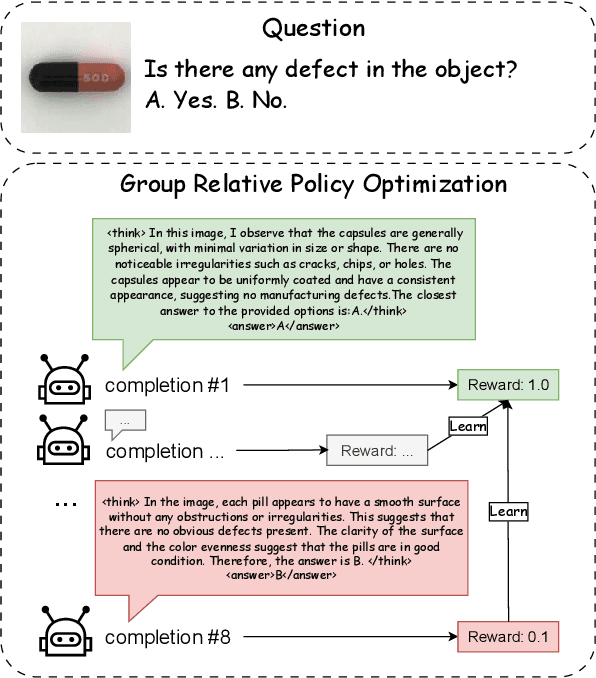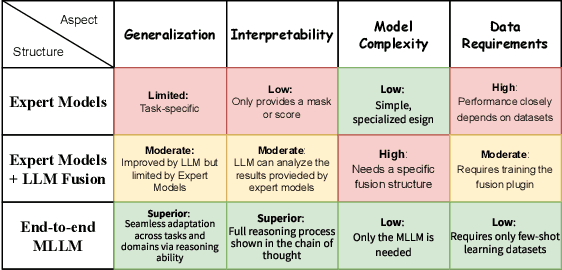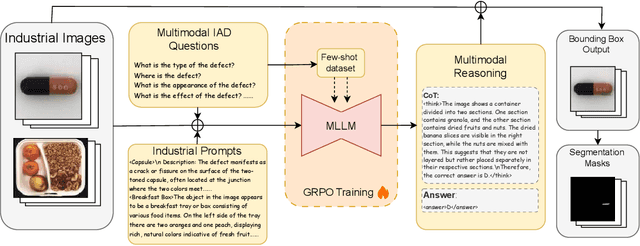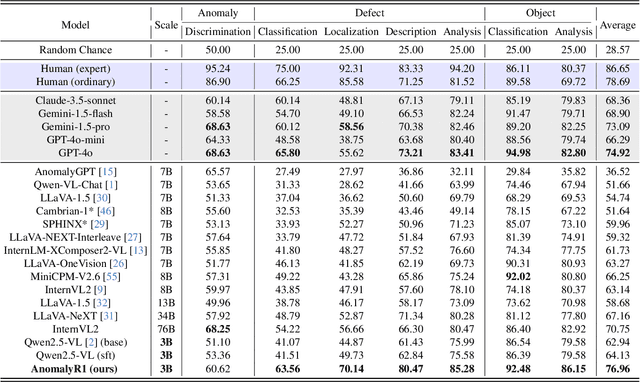Gangshan Wu
SAM 2++: Tracking Anything at Any Granularity
Oct 22, 2025Abstract:Video tracking aims at finding the specific target in subsequent frames given its initial state. Due to the varying granularity of target states across different tasks, most existing trackers are tailored to a single task and heavily rely on custom-designed modules within the individual task, which limits their generalization and leads to redundancy in both model design and parameters. To unify video tracking tasks, we present SAM 2++, a unified model towards tracking at any granularity, including masks, boxes, and points. First, to extend target granularity, we design task-specific prompts to encode various task inputs into general prompt embeddings, and a unified decoder to unify diverse task results into a unified form pre-output. Next, to satisfy memory matching, the core operation of tracking, we introduce a task-adaptive memory mechanism that unifies memory across different granularities. Finally, we introduce a customized data engine to support tracking training at any granularity, producing a large and diverse video tracking dataset with rich annotations at three granularities, termed Tracking-Any-Granularity, which represents a comprehensive resource for training and benchmarking on unified tracking. Comprehensive experiments on multiple benchmarks confirm that SAM 2++ sets a new state of the art across diverse tracking tasks at different granularities, establishing a unified and robust tracking framework.
Pure-Pass: Fine-Grained, Adaptive Masking for Dynamic Token-Mixing Routing in Lightweight Image Super-Resolution
Oct 02, 2025Abstract:Image Super-Resolution (SR) aims to reconstruct high-resolution images from low-resolution counterparts, but the computational complexity of deep learning-based methods often hinders practical deployment. CAMixer is the pioneering work to integrate the advantages of existing lightweight SR methods and proposes a content-aware mixer to route token mixers of varied complexities according to the difficulty of content recovery. However, several limitations remain, such as poor adaptability, coarse-grained masking and spatial inflexibility, among others. We propose Pure-Pass (PP), a pixel-level masking mechanism that identifies pure pixels and exempts them from expensive computations. PP utilizes fixed color center points to classify pixels into distinct categories, enabling fine-grained, spatially flexible masking while maintaining adaptive flexibility. Integrated into the state-of-the-art ATD-light model, PP-ATD-light achieves superior SR performance with minimal overhead, outperforming CAMixer-ATD-light in reconstruction quality and parameter efficiency when saving a similar amount of computation.
ObjFiller-3D: Consistent Multi-view 3D Inpainting via Video Diffusion Models
Aug 25, 2025Abstract:3D inpainting often relies on multi-view 2D image inpainting, where the inherent inconsistencies across different inpainted views can result in blurred textures, spatial discontinuities, and distracting visual artifacts. These inconsistencies pose significant challenges when striving for accurate and realistic 3D object completion, particularly in applications that demand high fidelity and structural coherence. To overcome these limitations, we propose ObjFiller-3D, a novel method designed for the completion and editing of high-quality and consistent 3D objects. Instead of employing a conventional 2D image inpainting model, our approach leverages a curated selection of state-of-the-art video editing model to fill in the masked regions of 3D objects. We analyze the representation gap between 3D and videos, and propose an adaptation of a video inpainting model for 3D scene inpainting. In addition, we introduce a reference-based 3D inpainting method to further enhance the quality of reconstruction. Experiments across diverse datasets show that compared to previous methods, ObjFiller-3D produces more faithful and fine-grained reconstructions (PSNR of 26.6 vs. NeRFiller (15.9) and LPIPS of 0.19 vs. Instant3dit (0.25)). Moreover, it demonstrates strong potential for practical deployment in real-world 3D editing applications. Project page: https://objfiller3d.github.io/ Code: https://github.com/objfiller3d/ObjFiller-3D .
MTNet: Learning modality-aware representation with transformer for RGBT tracking
Aug 24, 2025Abstract:The ability to learn robust multi-modality representation has played a critical role in the development of RGBT tracking. However, the regular fusion paradigm and the invariable tracking template remain restrictive to the feature interaction. In this paper, we propose a modality-aware tracker based on transformer, termed MTNet. Specifically, a modality-aware network is presented to explore modality-specific cues, which contains both channel aggregation and distribution module(CADM) and spatial similarity perception module (SSPM). A transformer fusion network is then applied to capture global dependencies to reinforce instance representations. To estimate the precise location and tackle the challenges, such as scale variation and deformation, we design a trident prediction head and a dynamic update strategy which jointly maintain a reliable template for facilitating inter-frame communication. Extensive experiments validate that the proposed method achieves satisfactory results compared with the state-of-the-art competitors on three RGBT benchmarks while reaching real-time speed.
Spatial-Temporal Human-Object Interaction Detection
Aug 24, 2025Abstract:In this paper, we propose a new instance-level human-object interaction detection task on videos called ST-HOID, which aims to distinguish fine-grained human-object interactions (HOIs) and the trajectories of subjects and objects. It is motivated by the fact that HOI is crucial for human-centric video content understanding. To solve ST-HOID, we propose a novel method consisting of an object trajectory detection module and an interaction reasoning module. Furthermore, we construct the first dataset named VidOR-HOID for ST-HOID evaluation, which contains 10,831 spatial-temporal HOI instances. We conduct extensive experiments to evaluate the effectiveness of our method. The experimental results demonstrate that our method outperforms the baselines generated by the state-of-the-art methods of image human-object interaction detection, video visual relation detection and video human-object interaction recognition.
CoMo: Learning Continuous Latent Motion from Internet Videos for Scalable Robot Learning
May 22, 2025Abstract:Learning latent motion from Internet videos is crucial for building generalist robots. However, existing discrete latent action methods suffer from information loss and struggle with complex and fine-grained dynamics. We propose CoMo, which aims to learn more informative continuous motion representations from diverse, internet-scale videos. CoMo employs a early temporal feature difference mechanism to prevent model collapse and suppress static appearance noise, effectively discouraging shortcut learning problem. Furthermore, guided by the information bottleneck principle, we constrain the latent motion embedding dimensionality to achieve a better balance between retaining sufficient action-relevant information and minimizing the inclusion of action-irrelevant appearance noise. Additionally, we also introduce two new metrics for more robustly and affordably evaluating motion and guiding motion learning methods development: (i) the linear probing MSE of action prediction, and (ii) the cosine similarity between past-to-current and future-to-current motion embeddings. Critically, CoMo exhibits strong zero-shot generalization, enabling it to generate continuous pseudo actions for previously unseen video domains. This capability facilitates unified policy joint learning using pseudo actions derived from various action-less video datasets (such as cross-embodiment videos and, notably, human demonstration videos), potentially augmented with limited labeled robot data. Extensive experiments show that policies co-trained with CoMo pseudo actions achieve superior performance with both diffusion and autoregressive architectures in simulated and real-world settings.
RGB-D Tracking via Hierarchical Modality Aggregation and Distribution Network
Apr 24, 2025Abstract:The integration of dual-modal features has been pivotal in advancing RGB-Depth (RGB-D) tracking. However, current trackers are less efficient and focus solely on single-level features, resulting in weaker robustness in fusion and slower speeds that fail to meet the demands of real-world applications. In this paper, we introduce a novel network, denoted as HMAD (Hierarchical Modality Aggregation and Distribution), which addresses these challenges. HMAD leverages the distinct feature representation strengths of RGB and depth modalities, giving prominence to a hierarchical approach for feature distribution and fusion, thereby enhancing the robustness of RGB-D tracking. Experimental results on various RGB-D datasets demonstrate that HMAD achieves state-of-the-art performance. Moreover, real-world experiments further validate HMAD's capacity to effectively handle a spectrum of tracking challenges in real-time scenarios.
RGB-D Video Object Segmentation via Enhanced Multi-store Feature Memory
Apr 23, 2025Abstract:The RGB-Depth (RGB-D) Video Object Segmentation (VOS) aims to integrate the fine-grained texture information of RGB with the spatial geometric clues of depth modality, boosting the performance of segmentation. However, off-the-shelf RGB-D segmentation methods fail to fully explore cross-modal information and suffer from object drift during long-term prediction. In this paper, we propose a novel RGB-D VOS method via multi-store feature memory for robust segmentation. Specifically, we design the hierarchical modality selection and fusion, which adaptively combines features from both modalities. Additionally, we develop a segmentation refinement module that effectively utilizes the Segmentation Anything Model (SAM) to refine the segmentation mask, ensuring more reliable results as memory to guide subsequent segmentation tasks. By leveraging spatio-temporal embedding and modality embedding, mixed prompts and fused images are fed into SAM to unleash its potential in RGB-D VOS. Experimental results show that the proposed method achieves state-of-the-art performance on the latest RGB-D VOS benchmark.
NTIRE 2025 Challenge on Image Super-Resolution ($\times$4): Methods and Results
Apr 20, 2025Abstract:This paper presents the NTIRE 2025 image super-resolution ($\times$4) challenge, one of the associated competitions of the 10th NTIRE Workshop at CVPR 2025. The challenge aims to recover high-resolution (HR) images from low-resolution (LR) counterparts generated through bicubic downsampling with a $\times$4 scaling factor. The objective is to develop effective network designs or solutions that achieve state-of-the-art SR performance. To reflect the dual objectives of image SR research, the challenge includes two sub-tracks: (1) a restoration track, emphasizes pixel-wise accuracy and ranks submissions based on PSNR; (2) a perceptual track, focuses on visual realism and ranks results by a perceptual score. A total of 286 participants registered for the competition, with 25 teams submitting valid entries. This report summarizes the challenge design, datasets, evaluation protocol, the main results, and methods of each team. The challenge serves as a benchmark to advance the state of the art and foster progress in image SR.
AnomalyR1: A GRPO-based End-to-end MLLM for Industrial Anomaly Detection
Apr 16, 2025



Abstract:Industrial Anomaly Detection (IAD) poses a formidable challenge due to the scarcity of defective samples, making it imperative to deploy models capable of robust generalization to detect unseen anomalies effectively. Traditional approaches, often constrained by hand-crafted features or domain-specific expert models, struggle to address this limitation, underscoring the need for a paradigm shift. We introduce AnomalyR1, a pioneering framework that leverages VLM-R1, a Multimodal Large Language Model (MLLM) renowned for its exceptional generalization and interpretability, to revolutionize IAD. By integrating MLLM with Group Relative Policy Optimization (GRPO), enhanced by our novel Reasoned Outcome Alignment Metric (ROAM), AnomalyR1 achieves a fully end-to-end solution that autonomously processes inputs of image and domain knowledge, reasons through analysis, and generates precise anomaly localizations and masks. Based on the latest multimodal IAD benchmark, our compact 3-billion-parameter model outperforms existing methods, establishing state-of-the-art results. As MLLM capabilities continue to advance, this study is the first to deliver an end-to-end VLM-based IAD solution that demonstrates the transformative potential of ROAM-enhanced GRPO, positioning our framework as a forward-looking cornerstone for next-generation intelligent anomaly detection systems in industrial applications with limited defective data.
 Add to Chrome
Add to Chrome Add to Firefox
Add to Firefox Add to Edge
Add to Edge